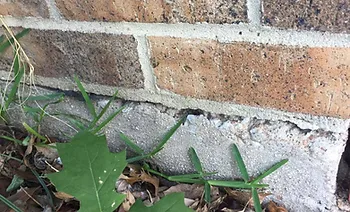
Building foundational cracks is a commonly found problem in many concrete-poured structures. They can occur in single-family homes, apartment buildings, or condominium complexes. They are by no means limited to the residential sector. It is just as common in the commercial, retail, and industrial sectors throughout Canada. Temperature change and ground movement are among the leading causes. Many foundation cracks are not necessarily of immediate concern as in the case of gradual shifting and/or “settling” property. Others, due to substandard construction or erosion, maybe more serious and could pose significant short and long-term issues for the property.
Unsure if you need an expert to visit your condo, apartment, or multi-dwelling buildings? Here are the top 15 warning signs that may indicate a potential failure in the property’s foundation.
- Crumbling concrete
- Flaking concrete
- Cracked walls
- Floor cracks and gaps (e.g. cracks in the basement floor)
- Calcium stains
- Wet basement
- Leaky basement
- Pyrite
- Water damage
- Soil shifting
- Sloping landscape
- Sagging floors
- Warped ceilings
- Concrete contraction
- Poorly fitting doors and windows
Spot a crack in your foundation? The first step to repairing a foundation crack is to identify what type of crack it is.
Here are the 10 most common types:
- Horizontal
- Stair Step
- Hairline
- Vertical
- Diagonal
- Shrinkage
- Foundation Slab
- Non-Structural
- Wet Non-Structural
- Structural
Horizontal Cracks
Horizontal cracks in a foundation can be serious. This type of crack is often due to unbalanced soil and hydrostatic water pressuring/pressing against your foundation wall. You may notice the foundation bowing inwards and water leaking into the basement. Both block and poured foundations can develop horizontal cracks. Horizontal cracks are common, they are found below grade where the frost line is located and are often caused by the freezing and thawing cycle. Over time this can create unbalanced pressure on the foundation wall creating a horizontal crack.
TOK Tip: The good news is horizontal cracks can be permanently repaired with lifetime guarantees and transferable warranties by many repair professionals.
Stair Step Cracks
Block foundations are prone to “stair-step” cracks. These types of cracks happen along mortar joints and can pose a serious threat to the integrity of your basement foundation.
There are two common causes of stair-step cracks:
- Foundation settlement or localized sinking in one area
- Moisture-related problems outside your foundation
TOK Tip: If you can put more than a quarter in the foundation crack call a trusted source for inspection and repair options. While some mortar-based hairline cracks are common, anything larger may pose a significant threat.
Hairline Cracks
Hairline cracks are commonly found in new construction foundations across the country. They usually appear within the first year and are caused by the settling and drying of the new foundation. The good news is these cracks are usually cosmetic and can be repaired.
TOK Tip: If you are dealing with new construction and discover a hairline foundation crack, your building warranty may cover the repair cost. Make sure to take photos to document the crack and monitor progression.
Vertical Cracks
Vertical cracks in a foundation wall are less serious than horizontal cracks and usually do not pose a structural threat. They are commonly found in poured foundations running straight up and down your wall. Vertical cracks are one of the most common crack types found in basements. They are due to the foundation settling over time or the natural concrete curing process
TOK Tip: If there is no moisture and a quarter will not fit in the crack, there is likely no immediate threat. Take photos and monitor any crack progression. Repair with epoxy injection.
Diagonal Cracks
Like vertical cracks, most diagonal foundation cracks do not necessarily pose a serious threat to the structural integrity of the foundation. They are found running at a maximum of 30 degrees off vertical and are caused by the natural curing of the concrete foundation wall and/or settlement over time.
TOK Tip: When diagonal crack is spotted, take a photo, and document the date. If the crack is hairline and a quarter cannot fit into it, then there should be no immediate concern. Check again in 6 months. If the crack has continued to grow, then call a professional for further advice and consultation.
Shrinkage Cracks
Like hairline cracks, shrinkage foundation cracks happen when poured concrete foundations begin to dry out and lose moisture. New builds are prone to shrinkage cracks within the first year. These cracks are often vertical and pose little structural threat to your foundation. The only risk is if the property is in an area with high levels of Radon Gas that could potentially leak into the basement level.
Foundation Slab Cracks
Poured concrete slabs are prone to developing cracks over time. The challenge is understanding why the foundation slab crack has occurred. There are three common reasons: 1. Concrete Curing: The most common reason is the natural drying, settling, and curing of the concrete slab. This poses no structural threat and is mostly cosmetic. 2. Slab Settlement: If a new foundation slab develops cracks due to settlement issues; this is significant. This may be caused by poor, initial workmanship where the supporting ground was not sufficiently compacted or by poor soil conditions. Call a professional for an inspection right away. 3. Frost Heave: Crawl space slab foundations that sit at or above grade are at risk of frost heave. During freezing, moisture underneath the slab can freeze, expand, and cause the concrete to buckle
TOK Tip: If the crack is larger than a hairline, call a reputable expert to get advice on the cause and options to repair it.
Non-Structural Foundation Cracks
A non-structural foundation crack is one that normally does not pose a threat to the structure of the home, and typically only results in leaks during rainstorms or snow melt. Despite the lack of structural threat, water seepage into your basement can still be a serious matter that requires attention. Water leaking into your property can ruin contents, walls, and floors, and contribute to the growth of mold; especially in a fully-developed basement. Left unattended, these types of cracks may get worse and, at the very least, must be monitored.
Wet Non-Structural Foundation Cracks
This type of crack is the result of foundation shrinkage due to water evaporating from the concrete. It would typically happen within the first month after a foundation is poured. The wetter the concrete mix was initially, the more shrinkage would happen, increasing the likelihood of cracks forming. The natural setting of the concrete can also lead to cracks.
TOK Tip: If you spot water/moisture coming from a crack the faster you contact the original contractor the better. Alberta’s quickly changing weather/humidity patterns can often aggravate this issue.
Structural Foundation Cracks
These types of cracks are extremely serious as they pose a risk to the integrity of any structure. A sure sign of a structural deficiency are horizontal cracks, and cracks wider than a 1/4 inch. Structural foundation cracks are normally the result of movement, whether it’s caused by temperature changes, soil pressure, or soil shrinkage. Because the crack was initially caused by stress resulting from movement which may continue, temporary solutions (epoxy) alone are not generally enough to ensure the repair of the crack. Further reinforcement, in the form of carbon fiber countersunk staples or straps, is often necessary to ensure that the crack does not expand.
TOK Tip: If you spot water or moisture coming from a crack; the faster you act the better. Edmonton’s quickly changing weather patterns can cause the crack to grow and may lead to more water issues.


